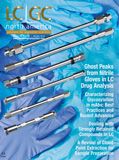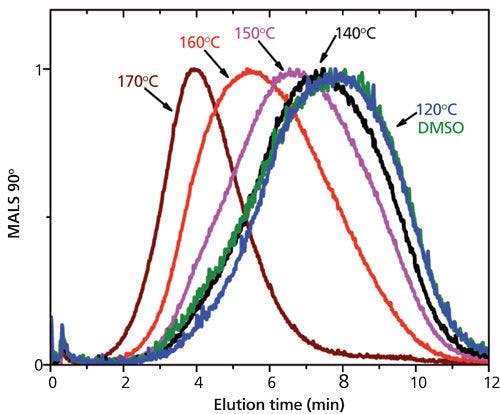Monitoring Drug Behavior Using High Performance Affinity Chromatography
Affinity separations offer great potential for pharmaceutical analysis.
There is a growing demand in the pharmaceutical industry for fast and selective separation methods to monitor drug behavior in small-volume biological samples. David S. Hage from the University of Nebraska-Lincoln has recently developed a series of methods using affinity chromatography and related techniques for this purpose. LCGC interviewed him about this work.
In your view, what are the main challenges faced by scientists working in the pharmaceutical industry right now?
Hage: A great deal of past research in the creation of new separation techniques for pharmaceutical analysis has sought to improve the speed, efficiency, and information content of these methods. These are still ongoing needs as scientists in this field seek to work with increasingly complex agents or materials, such as biopharmaceuticals or samples from the areas of proteomics, glycomics, and metabolomics. Other growing needs call for fast and selective separation methods that can be used directly with small amounts of biological samples and that require minimal pretreatment. This last set of needs is where affinity chromatography and related separation methods can be especially valuable.
One strand of your research focuses on the development of affinity chromatography for characterizing drug–protein interactions. Why is this an important area of research in pharmaceutical analysis?
Hage: Most routine types of pharmaceutical analysis, as conducted by methods like reversed-phase chromatography and liquid chromatography-mass spectrometry (LC–MS), are concerned with measuring the amount of a drug or drug metabolite in a sample, or the change in this amount over time. The use of affinity chromatography to characterize drug–protein binding builds on these efforts by also looking at how a drug or its metabolites can interact with the proteins or other components in a biological system. This information provides a more complete picture of how the drug is behaving in an organism and how its pharmaceutical activity, rather than just its total concentration, may change over time or with a disease state. This type of information on drug–protein interactions also has great potential in the area of personalized medicine in that it may eventually allow the treatment of patients with pharmaceutical agents to be adjusted on an individual basis.
What are the basic principles of affinity chromatography and high performance affinity chromatography (HPAC)? What are the main applications of the technique?
Hage: Affinity chromatography is a type of liquid chromatography that is based on the selective and reversible interactions of many biological systems. The stationary phase in this method is an immobilized biological agent, such as an antibody or transport protein, that can be used to bind and retain a complementary target from an applied sample. High performance affinity chromatography (HPAC) is a type of affinity chromatography in which the immobilized biological agent is used within a high performance liquid chromatography (HPLC) column or HPLC system.
Affinity chromatography has been used for many years as a powerful tool for the selective purification or isolation of biological compounds. In recent years, affinity chromatography and HPAC have also seen considerable growth as methods for the analysis of specific compounds in biological samples and as tools for studying biological interactions. These separation methods can be used alone or in combination with other techniques, including reversed-phase chromatography and MS. Affinity-based separations have now been reported for a broad group of targets that have ranged from drugs, hormones, and other small biological molecules up to antibodies, enzymes, receptors, viral particles, and cells. In addition, HPAC and affinity columns can be used in flow-based biosensors and as part of miniaturized analytical devices.
You have recently published work using HPAC to analyze the interactions between glimepiride and human serum albumin (1). What led you to begin this work?
Hage: Human serum albumin (HSA) is an important serum transport for glimepiride and many other drugs. Glimepiride is a sulfonylurea drug, which is a common class of drugs used to treat type II diabetes. It is known that HSA can be modified by glucose in a process called “glycation,” and that the extent of this process increases during diabetes. We have been interested in seeing how the modification of HSA by glycation affects the interactions of this protein with sulfonylurea drugs, including glimepiride, and in how these changes might then alter the amount of these drugs that will bind to HSA in patients with diabetes.
Did you experience any challenges and, if so, how did you overcome them?
Hage: Early in this type of work we had to develop and validate methods for preparing HPAC columns that contained either normal HSA or glycated HSA and that could be used as models for the soluble forms of these proteins. We have since identified several ways of making columns that contain these proteins and that give good agreement with the drug binding behavior that is seen for soluble HSA. This development led to the possibility of using HPAC and these columns as a biomimetic system for modeling drug–protein interactions in blood.
Our work with glimepiride in this approach met with several additional challenges. One such challenge was the relatively low solubility of this drug in aqueous solutions. The low solubility of this drug has in the past limited the types of conditions that could be used in other methods to examine binding by this drug with HSA. However, we were able to identify experimental conditions and methods in HPAC that allowed us to examine these interactions and at concentrations over which glimepiride was soluble in a physiological buffer. We also found that this drug has multiple binding sites on HSA and that some of these sites can take part in allosteric interactions with this drug. By using several site-specific probes for our studies, we were able to obtain binding constants or information on the interactions for glimepiride at each of these sites. The result was a detailed picture of glimepiride binding with HSA and in how these various interactions were affected by the glycation of this protein.
At HPLC 2015 in Geneva, you presented a keynote lecture showing the use of microcolumns in HPAC to characterize drug interactions. Why is reducing column size of interest in HPAC?
Hage: The agent that is used as a stationary phase in HPAC usually has both strong and specific binding for its target. This combination means that short columns, or microcolumns, can often be used in HPAC to obtain a selective and high-resolution separation of this target from other sample components in a relatively short period of time. Other advantages of using these microcolumns include their need for only small amounts of the binding agent, their low back pressures, their low nonspecific binding, the potential of using them with other types of HPLC columns or detectors, and the possibility of using these microcolumns in some types of experiments that are not feasible with traditional HPLC columns or affinity systems.
What are the key factors to consider when using microcolumns in HPAC? Are there limitations?
Hage: The steps that are used to immobilize the binding agent within the microcolumns are important to consider because a large amount of binding agent for each unit volume is usually desirable to obtain high retention and resolution. The short amounts of time that samples spend in these columns and the relatively small binding capacities of these columns are other factors to keep in mind, because they can lead to kinetic effects that are not usually seen with larger columns. The same effects can also be used to provide some unique applications for affinity microcolumns when examining the binding strength or rates of drug–protein interactions.
In 2014, you coauthored a paper analyzing free-drug fractions of sulfonylurea drugs by ultrafast affinity extraction (2). Why did you develop this method? What advantages does it offer?
Hage: This was the next step in our work to see if the changes in drug–protein binding that we were observing as a result of glycation were also affecting the free drug fractions, or biologically active forms, of these drugs at clinically relevant concentrations. The approach that we developed based on ultrafast affinity extraction made it possible to directly measure these free fractions in a matter of minutes per experiment and using only microliter quantities of each sample. The results gave good correlation with those of the reference methods and with the changes that were predicted based on our previous studies of the binding by HSA or glycated HSA with these drugs (2). The same approach can be used for other drugs and is now being used with clinical samples, making it a possible tool that can be used in the future for personalized medicine.
Is there anything you would like to add?
Hage: I think the area of affinity separations and HPAC offers a great number of opportunities for pharmaceutical analysis. I also believe we are just now beginning to realize the potential of these techniques to measure drugs or proteins and to characterize the interactions between these agents. I think these possibilities, as well as the advances that are being made in supports, binding agents, and formats that can be used with affinity separations, will continue to provide great promise for these methods in the years to come.
References
- R. Matsuda, Z. Li, X. Zheng, and D.S. Hage, J. Chromatogr. A In Press, DOI: 10.1016/j.chroma.2015.07.012 (2015).
- X. Zheng, R. Matsuda, and D.S. Hage, J. Chromatogr. A1371, 82–89 (2014).

Common Challenges in Nitrosamine Analysis: An LCGC International Peer Exchange
April 15th 2025A recent roundtable discussion featuring Aloka Srinivasan of Raaha, Mayank Bhanti of the United States Pharmacopeia (USP), and Amber Burch of Purisys discussed the challenges surrounding nitrosamine analysis in pharmaceuticals.













